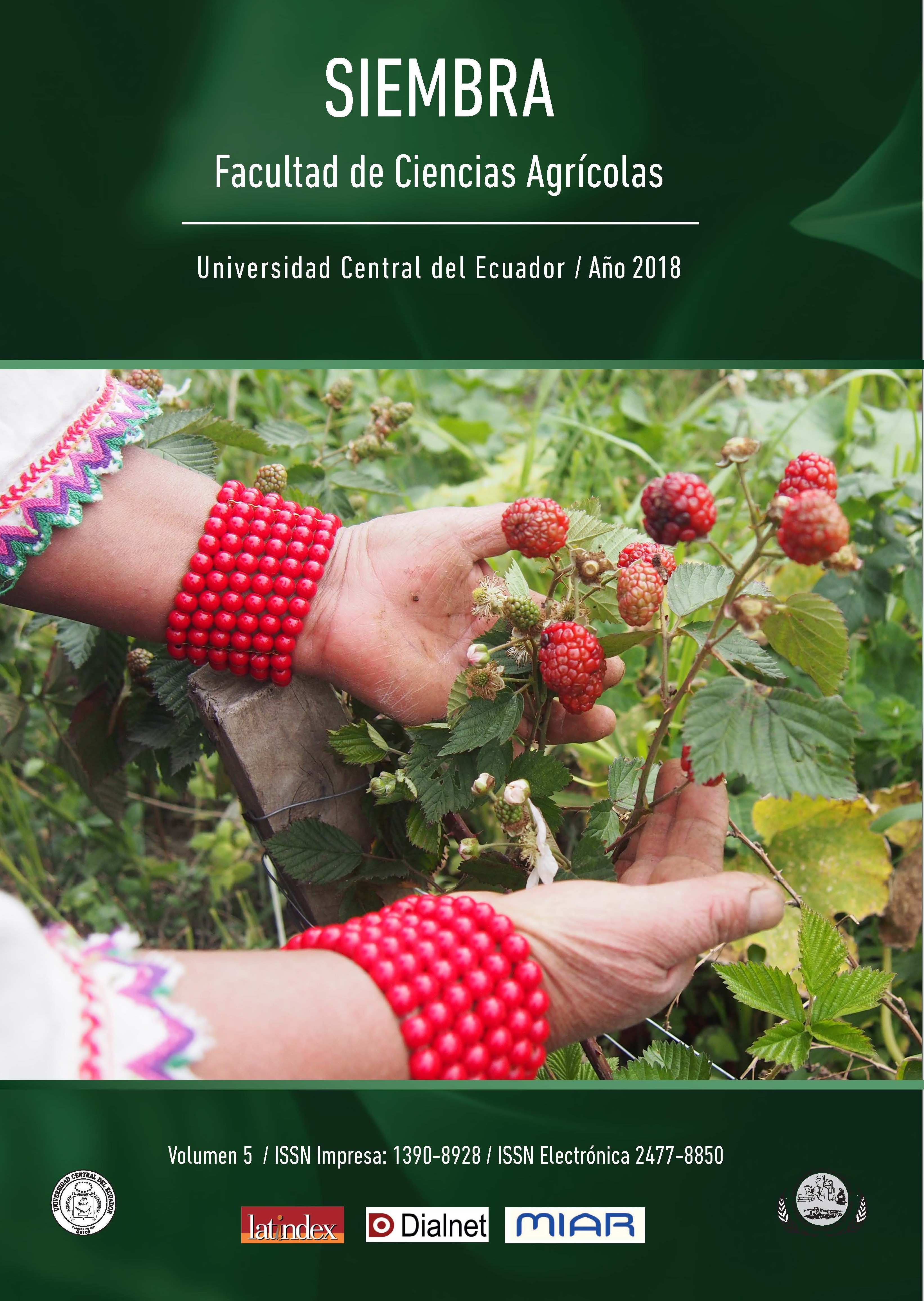The Class A pan coefficient to estimate the reference evapotranspiration for the Tumbaco valley
Main Article Content
Abstract
The precise determination of the Class A pan coefficients allows to estimate the reference evapotranspiration and real values of crop water requirements. Daily and monthly climatological data was used to determine the pan coefficient (Kp) and the reference evapotranspiration (ETo). The models evaluated to determine Kp were: Allen – Pruit, Cuenca, Pereira, Snyder and the computed coefficient. The following indices were used to evaluate the cross analysis between the models to compute ETo: absolute mean error, concordance coefficient and the coefficient of determination. The results show that: i) for daily data, the Allen - Pruitt and Snyder contrast presented the best indices; ii) for monthly data, the Snyder and the computed coefficient contrast presented indices with higher accuracy; iii) the maximum average ETo was registered in August with 139.32 mm and the minimum in April with about 76.54 mm. The main conclusions are: i) for monthly average climatological data, the Snyder and the computed method can be used to determine Kp and the Snyder method for daily data and ii) the standard Penman Monteith FAO 56 method presented poor inferential indices for daily data and better indices for monthly data, considering the environmental conditions of the Tumbaco valley.
Downloads
Metrics
Article Details

This work is licensed under a Creative Commons Attribution-NonCommercial 4.0 International License.
The authors who publish in Siembra know and accept the following conditions:
- Authors retain the copyright and grant Siembra the right of first publication of the work, under the Creative Commons Attribution License. Third parties are allowed to use what has been published as long as they refer to the author or authors of the work and its publication in this journal.
![]() This content is licensed under a Creative Commons Attribution-Noncommercial 4.0 International (CC BY-NC 4.0).
This content is licensed under a Creative Commons Attribution-Noncommercial 4.0 International (CC BY-NC 4.0).
- Authors maintain the copyright and guarantee Siembra the right to publish the manuscript through the channels it considers appropriate.
- Authors may establish on their own additional agreements for the non-exclusive distribution of the version of the work published in Siembra, acknowledging their initial publication in the same, such as in institutional repositories.
- Authors are authorized to disseminate their work electronically once the manuscript is accepted for publication.
References
Allen, R., Pereira, L., Raes, D., & Smith, M. (2006). Evapotranspiración del cultivo. Roma: FAO. 300p.
Bhabagrahi, S., Imtisenla, W., Bidyut, D., & Bhagwati, B. (2012). Standardization of Reference Evapotranspiration Models for a Subhumid Valley Rangeland in the Eastern Himalayas. Journal of Irrigation and Drainage Engineering, 138, 880-895.
Chai, T. (2014). Root mean square error (RMSE) or mean absolute erro (MAE)?. Geoscientific Model Development Discussions, 7, 1247-1250.
Doorenbos, J., & Pruitt, W. (1977). Guidelines for predicting crop water requirements. Roma: FAO.
Grismer, M., Orang, M., Snyder, R., & Matyac, R. (2002). Pan evaporation to reference evapotranspiration conversion methods. Journal of Irrigation and Drainage Engineering, 128, 180-184.
Hamilton, Y. (2013). Análisis de la evapotranspiración potencial en función de elementos climáticos en la zona circunlacustre de la cuenca del Titicaca Peruano. ECIPerú, 9, 46-52.
Hernández, K. (2014). Evaluación del método FAO-56 en Costa Rica. Meterorología y oceanografía, 13, 56-67.
Pereira, A., Villa, N., Pereira, A., & Barbieri, V. (1995). A model for the class A pan coefficient. Agricultural and Forest Meteorology, 76, 75-82.
Pupo, L., & García, P. (2009). Estimación de los coeficientes de tanque “A” para calcular la evapotranspiración del cultivo de referencia en la zona sur del Uruguay. Agrociencia, 13, 47-51.
Samuels, P. (2014). Pearson Correlation. Disponible en: http://www.statstutor.ac.uk/resources/uploaded/pearsoncorrelation3.pdf
Sentelhas, P., & Folegatti, M. (2003). Class A pan coefficients (Kp) to estimate daily reference evapotranspiration (ETo). Revista Brasileira de Engenharia Agricola e Ambiental, 7, 111-115.
Snyder, R., Orang, M., Matyac, S., & Grismer, M. (2005). Simplified Estimation of Reference Evapotranspiration from Pan Evaporation Data in California. Journal of Irrigation and Drainage Engineering, 131, 249-253.
Stannard, D. (1993). Comparison of Penman-Monteith, Shuttleworth-Wallace, and Modified Priestley-Taylor Evapotranspiration Models for wildland vegetation in semiarid rangeland. Water Resources Research, 29, 1379-1392.
Willmott, C., Robeson, S., & Matsuura, K. (2011). A refined index of model performance. International Journal of climatology, 32, 2088-2094.





